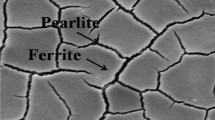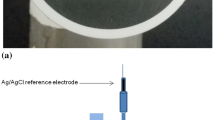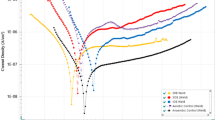Abstract
The differences between the general corrosion and microbiologically influenced corrosion (MIC) of steels were investigated in terms of its electrochemical behavior and surface phenomena. The corrosion potential of steels in the absence of SRB (sulfate-reducing bacteria) shifted to a negative value with the immersion time. However, the potential of the presence of SRB shifted to a positive value after 30 days' incubation, indicating the growth of SRB biofilms on the test metal specimens and the formation of corrosion products. In addition, the color of a medium inoculated with SRB changed from gray to black. The change in color appeared to be caused by the formation of pyrites (FeS) as a corrosion product, while no significant change in color was observed in a medium without SRB inoculation. Moreover, corrosion rates of various steels tested for MIC were higher compared to those of steels in the absence of SRB. In particular, the corrosion current density of TMCP steels in the presence of SRB was larger than that of other steels. Pitting corrosion was also observed at the surface of all steels in the SRB-inoculated medium. The pitting corrosion likely occurred due to SRB that was associated with the increasing corrosion rates through increasing cathodic reactions, which caused a reduction of sulfate to sulfide as well as the formation of an oxygen concentration cell.
Similar content being viewed by others
References
A. F. Gaudy and E. T. Gaudy,Microbiology for Environmental Scientists and Engineers, p. 183, McGraw-Hill, New York (1980).
S. Nishikawa, A. Hirano, T. Tsuneki,Proc. Of the 100 th JSCE Symposium on Pheomean and Mechanisms for Microbiologically Influenced Corrosion, p. 1, Tokyo, Japan (1994).
N. Mura, inProceedings of the 89 th Corrosion & Corrosion Control Institute Symposium, p. 49, Tokyo, Japan (1992).
S. W. Borenstein,Mat. Perform. 30, 52 (1991).
Oil Companies International Marine Forum,Factors Influencing Accelerated Corrosion of Caro Oil Tank, p. 1, London SWIH 9BU, England (1997).
A. Hagenauer, R. Hilpert and T. Hack,Week Stoffe and Corrosion 45, 355 (1994).
K. R. Sreekumari, M. Ozawa, Y. Kikuchi,IDJI. International 40, 54 (2000).
M. Yama,Proc. 10 th International Biodeterioration and Biodegradation Symposium, p. 4, Hamburg, Germany (1994).
G. J. Licina,Source Book for Microbiologically Influenced Corrosion in Nuclear Power Plants, p. 35, Electric Power Research Institute Report (1998).
K. M. Moon, S. C. Koh,Corrosion Science and Technology 5, 187 (2004).
Y. Kikuchi, K. Tohomoto, M. Ozawa, T. Kanamaru,Corrosion Paper, p. 170, NACE (1999).
Y. Toyuo,Corrosion Engineering & Corrosion Technology (ed. Corona), p. 361, Japan (1975).
S. Hyra,J. Jpn. Inst. Met. 9, 104 (1970).
L. Graf and W. Wittich,Werkst. Korros. 17, 385 (1966).
J. You,J. Jpn. Inst. Met. 58, 775 (1994).
F. Kajiyama,Zairyo-to-Kankyo 46, 326 (1997).
Y. Kikuchi and K. Tohomoto,Zairyo-to-Kankyo 47, 467 (1998).
A. K. Tiller,Biologically Induced Corrosion (ed. S. C. Dexter), p. 8, NACE, Houston (1986).
Y. Kikuchi,Technical Explanation, Joining and Welding Research Institute, Osaka University,7, 119 (1999).
D. Mishra, D. J. Kim, J. G. Ahn, and Y. H. Rhee,Met. Mater.-Int. 11, 249 (2005).
Author information
Authors and Affiliations
Corresponding author
Rights and permissions
About this article
Cite this article
Moon, KM., Cho, HR., Lee, MH. et al. Electrochemical analysis of the microbiologically influenced corrosion of steels by sulfate-reducing bacteria. Met. Mater. Int. 13, 211–216 (2007). https://doi.org/10.1007/BF03027807
Issue Date:
DOI: https://doi.org/10.1007/BF03027807




